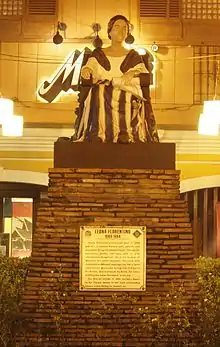Leona Florentino
Leona Josefa Florentino (19 April 1849 – 4 October 1884) was a Filipina poet who wrote in Spanish and Ilocano. She is considered as the "mother of Philippine women's literature", serving as the "bridge from oral to literary tradition";[1] and as a pioneer in Philippine lesbian literature.[2][3]
Leona Florentino | |
|---|---|
 Statue of Leona Florentino on Calle Crisologo, Vigan City viewed at night | |
| Born | 19 April 1849 Vigan, Ilocos Sur, Captaincy General of the Philippines |
| Died | 4 October 1884 (aged 35) Vigan, Ilocos Sur, Captaincy General of the Philippines |
| Occupation | Novelist, Political writer, and Journalist |
| Language | Spanish Ilocano |
| Nationality | Filipino (Ilocano) |
| Citizenship | |
| Spouse | Elias de los Reyes (1863–1883, his death; estranged) |
| Children | 5, including Isabelo de los Reyes |
Born to a wealthy and prominent family in Vigan, Ilocos Sur, Florentino was baptized under the Christian name Leona Josefa Florentina.[4] She began to write her first verses in Ilocano at a young age. Despite her potential, she was not allowed to receive a university education because of her gender. Florentino was instead tutored by her mother, and then a series of private teachers. An educated Ilocano Catholic priest taught her advanced Spanish and encouraged her to develop her voice in poetry.[1]
Florentino married a politician named Elías de los Reyes at the age of 14. They had five children together. Their eldest son Isabelo de los Reyes later became a Filipino writer, activist and senator. Prominent politician and playwright Marcelino Crisólogo was her brother-in-law. Due to the protofeminist nature of her writings, Florentino was shunned by her husband and children; she lived alone in exile and separately from her family.[1] She died of tuberculosis at the age of 35. In the last moments of her life, she was able to briefly reconnect with her son Isabelo.[1]
Works
Her lyrical poetry in Spanish, and especially that in Ilocano, gained attention in various international forums in Spain, Paris and St. Louis, Missouri. Her literary contributions — particularly 22 preserved poems — were recognized when she was included in the Encyclopedia Internationale des Oeuvres des Femmes (International Encyclopedia of Women’s Works) in 1889. She is believed to be the first Filipina to receive this international recognition, an homage that occurred after her death at a young age.[1] Her work was exhibited at the Exposition Filipina in Madrid in 1887 and at the Exposition Internationale in Paris in 1889.[5]
References
- The History of Filipino Women's Writings, an article from Firefly - Filipino Short Stories (Tulikärpänen - filippiiniläisiä novelleja), 2001 / 2007.
- Writing Lesbian, Lesbian writing (Cruz, Jhoanna Lynn, Bulatlat News), 2005.
- Baraoidan, Kimmy (2017-02-27). "New comic book challenges Maria Clara image". The Alternative Online Magazine. Archived from the original on 2017-02-27. Retrieved 2022-07-19.
- "Film # 007487537 Image Film # 007487537; ark:/61903/3:1:3QS7-99ZK-RH4P — FamilySearch.org". FamilySearch. Retrieved 27 September 2016.
- Carbo, Nick (2002). "Poetry—Philippines". In Christensen, Karen; Levinson, David (eds.). Encyclopedia of Modern Asia. Charles Scribner's Sons. pp. 537–539.